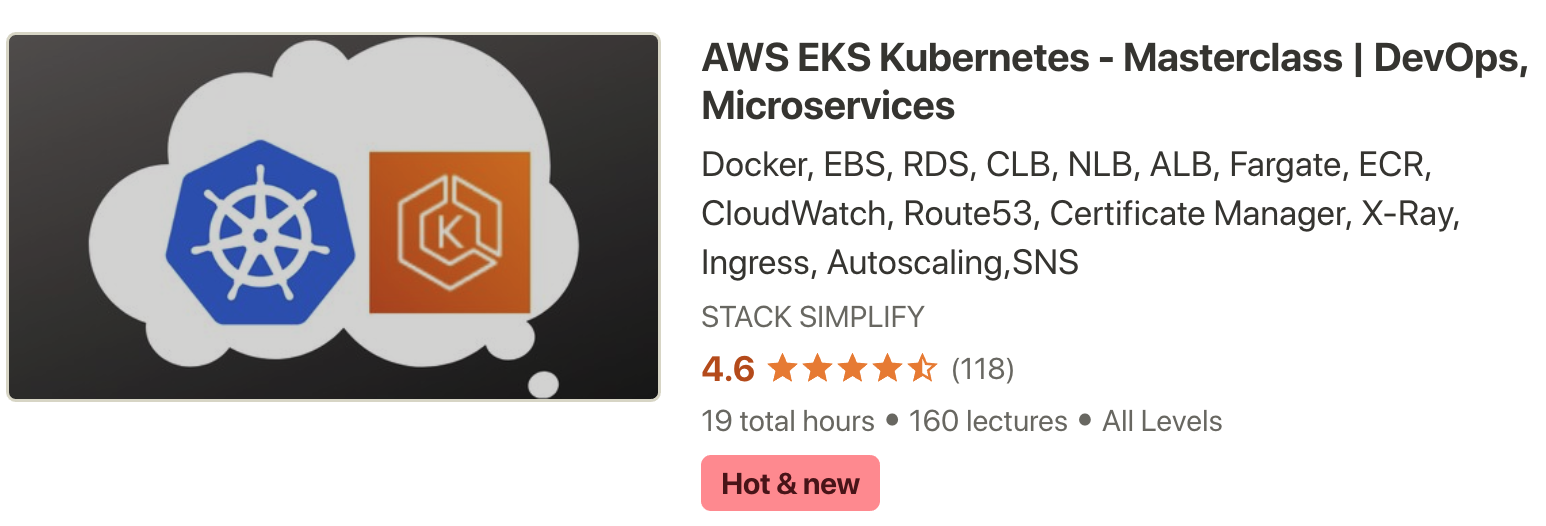Create EKS Cluster & Node Groups
Step-00: Introduction
- Understand about EKS Core Objects
- Control Plane
- Worker Nodes & Node Groups
- Fargate Profiles
- VPC
- Create EKS Cluster
- Associate EKS Cluster to IAM OIDC Provider
- Create EKS Node Groups
- Verify Cluster, Node Groups, EC2 Instances, IAM Policies and Node Groups
Step-01: Create EKS Cluster using eksctl
- It will take 15 to 20 minutes to create the Cluster Control Plane
# Create Cluster
eksctl create cluster --name=eksdemo1 \
--region=us-east-1 \
--zones=us-east-1a,us-east-1b \
--without-nodegroup
# Get List of clusters
eksctl get clusters
Step-02: Create & Associate IAM OIDC Provider for our EKS Cluster
- To enable and use AWS IAM roles for Kubernetes service accounts on our EKS cluster, we must create & associate OIDC identity provider.
- To do so using
eksctl we can use the below command.
- Use latest eksctl version (as on today the latest version is
0.21.0)
# Template
eksctl utils associate-iam-oidc-provider \
--region region-code \
--cluster <cluter-name> \
--approve
# Replace with region & cluster name
eksctl utils associate-iam-oidc-provider \
--region us-east-1 \
--cluster eksdemo1 \
--approve
Step-03: Create EC2 Keypair
- Create a new EC2 Keypair with name as
kube-demo
- This keypair we will use it when creating the EKS NodeGroup.
- This will help us to login to the EKS Worker Nodes using Terminal.
Step-04: Create Node Group with additional Add-Ons in Public Subnets
- These add-ons will create the respective IAM policies for us automatically within our Node Group role.
# Create Public Node Group
eksctl create nodegroup --cluster=eksdemo1 \
--region=us-east-1 \
--name=eksdemo1-ng-public1 \
--node-type=t3.medium \
--nodes=2 \
--nodes-min=2 \
--nodes-max=4 \
--node-volume-size=20 \
--ssh-access \
--ssh-public-key=kube-demo \
--managed \
--asg-access \
--external-dns-access \
--full-ecr-access \
--appmesh-access \
--alb-ingress-access
AWS EKS - Elastic Kubernetes Service - Masterclass

Step-05: Verify Cluster & Nodes
Verify NodeGroup subnets to confirm EC2 Instances are in Public Subnet
- Verify the node group subnet to ensure it created in public subnets
- Go to Services -> EKS -> eksdemo -> eksdemo1-ng1-public
- Click on Associated subnet in Details tab
- Click on Route Table Tab.
- We should see that internet route via Internet Gateway (0.0.0.0/0 -> igw-xxxxxxxx)
Verify Cluster, NodeGroup in EKS Management Console
- Go to Services -> Elastic Kubernetes Service -> eksdemo1
List Worker Nodes
# List EKS clusters
eksctl get cluster
# List NodeGroups in a cluster
eksctl get nodegroup --cluster=<clusterName>
# List Nodes in current kubernetes cluster
kubectl get nodes -o wide
# Our kubectl context should be automatically changed to new cluster
kubectl config view --minify
Verify Worker Node IAM Role and list of Policies
- Go to Services -> EC2 -> Worker Nodes
- Click on IAM Role associated to EC2 Worker Nodes
Verify Security Group Associated to Worker Nodes
- Go to Services -> EC2 -> Worker Nodes
- Click on Security Group associated to EC2 Instance which contains
remote in the name.
- Verify Control Plane Stack & Events
- Verify NodeGroup Stack & Events
Login to Worker Node using Keypai kube-demo
- Login to worker node
# For MAC or Linux or Windows10
ssh -i kube-demo.pem ec2-user@<Public-IP-of-Worker-Node>
# For Windows 7
Use putty
Step-06: Update Worker Nodes Security Group to allow all traffic
- We need to allow
All Traffic on worker node security group
Additional References
- https://docs.aws.amazon.com/eks/latest/userguide/enable-iam-roles-for-service-accounts.html
- https://docs.aws.amazon.com/eks/latest/userguide/create-service-account-iam-policy-and-role.html
